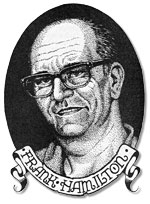Our thoughts go out to illustrator Frank Hamilton who, according to Ron Hanna of Wild Cat Books, has recently entered care at a nursing home. Here’s what Ron posted on the PulpMags group at Yahoo:
Nick Carr phoned Tom Johnson (Monday night) to report that Helen Deveny had called him to say that Frank Hamilton was in the nursing home and in really bad shape. I know a lot of you have admired Frank’s art for many years.
Frank Hamilton is one of pulp fandom’s greatest artists ever. I’m sure most of you “old-timers” either knew him, or have seen his art… Frank himself doesn’t expect to get well enough to ever leave the nursing home. I can provide a phone number and address to anyone wanting to send him a “Get Well” Card…
– Ron Hanna
Wild Cat Books
wildcat_books@yahoo.com
To echo what Ron wrote, the 88-year-old Frank Hamilton isn’t someone I’ve personally met or corresponded with, but he’s reached out to me, and mostly likely to many of you, through his carefully crafted homages to the pulps.

That’s a self-portrait, at left, he did in 1982 for the debut issue of the Johnsons’ zine Echoes called “The Bloody Seven.” (Click the image to see a larger version.)
In that debut issue, Ginger Johnson wrote a profile of Hamilton, which the Johnsons have graciously granted permission to excerpt here:
Shortly before World War II, Frank Hamilton gave all his copies of The Shadow and Doc Savage pulps to his boyhood chum, Charles T. Barner, who also had a considerable number of The Shadows. The years passed and memories of the pulps faded, as did his interest in art. When Bantam re-issued Doc Savage in 1964, a spark of nostalgia was struck, but these paperbacks were all that Frank could find to help revitalize his feelings for the pulps.
Frank remembers telling 14-year-old Brian, one of his sons, about The Shadow, The Spider and the others, and stressing vehemently that James Bama’s Doc Savage was an imposter, and wishing that he still had the Walter Baumhofer poster so he could show Brian the real Doc Savage!
In 1968, Charles Barner found about 38 Shadows that had escaped the paper drives of the war, and gave them to Frank. Most were coverless, but they were more than enough to get him into his own little, private, one-man fandom… or so he thought. He dug the old paint box out and started copying the covers that were there. He soon developed an appetite for more pulps as his paintings turned out well, considering the years he had been away from it. The artwork he considers most natural for him is black and white stippling; he is very apprehensive about doing oils, but I think he does a fantastic job with any style.
Frank gradually bought a number of Doc Savage pulps, but really wanted only those with Baumhofer covers. He now has all the Baumhofer’s from issue #1 to Baumhofer’s last in 1936.
Frank was also buying The Shadows, through the mail, from all over the country until be only needed three to have the complete run of 325. He finally managed to achieve number one, “The Living Shadow.” Later on he would receive, as a gift from Jack Deveny, the two remaining Shadows that completed his set.
In 1970 or 1971, Frank was introduced to the fanzine Pulp, by Bobby Van, who he met in a book store in New York. He subscribed and found names and addresses of fellow collectors… fans, like himself. He would never be the only pulp collector again! In fact, Pulp was where he made his fanzine debut. In the fourth issue he had published, anonymously, a small sketch of Captain Fury, followed by another of Doc Savage in the fifth issue.
Bob Weinberg then asked to use one of his Shadow drawings on the cover of Frank Eisgruber’s Gangland’s Doom. Frank sent Weinberg two drawings which were well accepted. They also brought a letter, a phone call and an autographed copy of Gangland’s Doom from Walter B. Gibson; who he later met in New York in 1975 and again at Frank’s own home in 1976.
As I said at the outset, our thoughts go out to Frank Hamilton. I should add that he also deserves our thanks. He’s contributed greatly to pulp fandom over the years. May his art continue inspiring old and new pulp fans.
Thank you, Frank Hamilton.
– William


The night I heard this, I pulled out all the books that I have featuring his artwork. Those pieces are incredible… stippling is such a painstaking process, and his skill simply shines.
This is indeed a sad day for pulp fans.
Don
[…] very sad news, but not wholly unexpected. Several weeks ago, I wrote a tribute to him when he moved into nursing card. Our thoughts and prayers go out to his […]